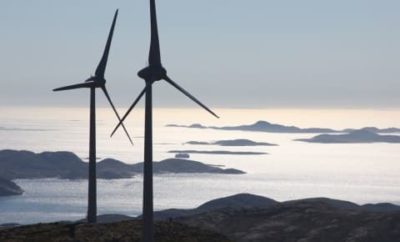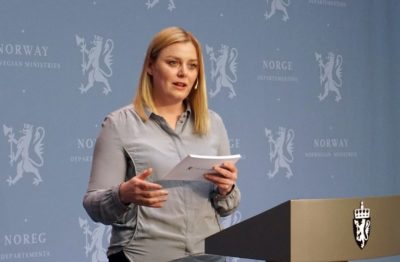The Norwegian government is proposing what it calls an “historic tightening” of regulations around wind power projects on land. The goal is to reduce conflict levels over the huge turbines that tower over the landscape and pose a threat to birds and other wildlife.

After weeks of wind power protests that turned ugly, Oil & Energy Minister Tina Bru sent a proposal to Parliament on Friday that had been prepared even before she was personally threatened by protesters last weekend.
Bru claimed the government has been listening to the protesters all along, and wants to strengthen both local and regional control over controversial wind power projects. Bru and her government colleagures also want to streamline and shorten the time it takes to handle wind energy licensing, and make sure major changes in projects aren’t made along the way.
“We need to clarify and update wind power policy, to give everyone involved a much more predictable framework,” Bru said. It currently can take years from the time a project is proposed until it’s realized, with the turbines (huge windmills) often increasing dramatically in height.
“After a thorough review of current practice, with input from various players, we propose an historic tightening with several measures for improvements to current practice,” Bru said.

Wind power presents a major dilemma in Norway, where efforts are underway to lessen reliance on the country’s oil and gas industry and promote renewable industry. Wind power presents great potential to do just that, but it also remains controversial because of the towering turbines that many consider to be unsightly and noisy. They also present a threat to birdlife and entail construction of roads and other infrastructure in what often are coastal- or mountainous wilderness areas. An earlier state plan was withdrawn because of the furor it raised.
Production of renewable energy remains critical if Norway is to become a low-emissions country, and wind power already provides electricity for around 500,000 people in Norway. It can also generate jobs, especially in the case of offshore wind farms that can provide more work for Norwegian offshore- and shipyards that traditionally have served the oil supply sector.
‘Negative environmental consequences’
Bru’s Oil & Energy Ministry readily acknowledges the “negative environmental consequences” of wind power, however, and now wants to provide for “a moderate and limited development of socially and economically profitable wind power” that will better address environmental and local concerns. Bru is acutely aware of how wind power has blown up “lots of engagement and debate” recently.
“We must learn from experience, and strengthen demands for environmental impact,” said Bru. “I still believe there’s room for more wind power development, but we need to reduce the pace of it.”
Plans include improving regional handling of wind power applications, firming up demands for local and regional support for wind power projects, setting much stricter deadlines for projects to actually be implemented as planned, expanding environmental impact studies and setting maximum height limits on turbines.
Changes loom for NVE, and current projects
Bru’s proposal was generally well-received, and stands to mean major changes in how the Norwegian Water Resources and Energy Directorate (NVE) functions. It has mostly been in charge of wind power projects, and caught lots of criticism in the process. It noted that it was taking Bru’s new proposal under advisement “and looks forward” to eventual action by the Parliament.
Protesters were encouraged but far from satisfied with Bru’s proposal, while opposition parties appeared keen to enhance it. The Labour, Center and Progress parties demanded that all 26 wind power licenses granted at present be reviewed to make sure rules have been followed. Projects found in violation of what was initially proposed and approved can be stopped. The Reds Party went even further, demanding that all licenses be frozen and re-evaluated in light of the new proposals.
The Greens Party has proposed halting the development of the most controversial project at present, on the island of Haramsøya off the coast of Møre og Romsdal between Ålesund and Kristiansund. It’s led to civil disobedience and prompted a woman from Haramsøya to initiate a hunger strike in front of Parliament in Oslo. The Greens, local residents and many others claim the construction of large turbines on the island’s scenic mountain plateau will destroy important nature.
Bru’s new plan “is important, and I hope the Haramsøya case will show how licenses need to be much better anchored,” Birgit Oline Kjerstad, leader of the protests on Haramsøya, told newspaper Klassekampen. “When they (government officials) are sharpening demands so much, I expect them to step in and halt this project.”
NewsInEnglish.no/Nina Berglund

